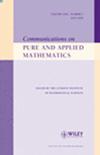库埃特流附近不稳定性研究的动力学方法
IF 2.7
1区 数学
Q1 MATHEMATICS
引用次数: 0
摘要
本文得到了小黏度Navier-Stokes方程ν>0 $\nu >0$在扰动处于临界空间Hx1Ly2 $H^1_xL_y^2$时,Couette流的最优不稳定阈值。更准确地说,我们引入了一种新的动力学方法来证明大小为ν12−δ0 $\nu ^{\frac{1}{2}-\delta _0}$的扰动与任何小的δ0>0 $\delta _0>0$的不稳定性,这意味着ν12 $\nu ^{\frac{1}{2}}$是尖锐的稳定阈值。在我们的方法中,我们证明了一个暂态指数增长,而不涉及特征值或伪谱。作为应用,对于靠近Couette流的剪切流的线性化欧拉方程,我们提供了一种新的工具来证明相应的Rayleigh算子的增长模态的存在性,并给出了特征值的精确位置。本文章由计算机程序翻译,如有差异,请以英文原文为准。
A dynamical approach to the study of instability near Couette flow
In this paper, we obtain the optimal instability threshold of the Couette flow for Navier–Stokes equations with small viscosity , when the perturbations are in the critical spaces . More precisely, we introduce a new dynamical approach to prove the instability for some perturbation of size with any small , which implies that is the sharp stability threshold. In our method, we prove a transient exponential growth without referring to eigenvalue or pseudo-spectrum. As an application, for the linearized Euler equations around shear flows that are near the Couette flow, we provide a new tool to prove the existence of growing modes for the corresponding Rayleigh operator and give a precise location of the eigenvalues.
求助全文
通过发布文献求助,成功后即可免费获取论文全文。
去求助
来源期刊
CiteScore
6.70
自引率
3.30%
发文量
59
审稿时长
>12 weeks
期刊介绍:
Communications on Pure and Applied Mathematics (ISSN 0010-3640) is published monthly, one volume per year, by John Wiley & Sons, Inc. © 2019.
The journal primarily publishes papers originating at or solicited by the Courant Institute of Mathematical Sciences. It features recent developments in applied mathematics, mathematical physics, and mathematical analysis. The topics include partial differential equations, computer science, and applied mathematics. CPAM is devoted to mathematical contributions to the sciences; both theoretical and applied papers, of original or expository type, are included.

 求助内容:
求助内容: 应助结果提醒方式:
应助结果提醒方式:


